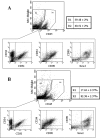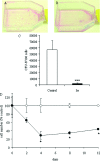Adipose tissue sensitivity to radiation exposure
- PMID: 19095959
- PMCID: PMC2631317
- DOI: 10.2353/ajpath.2009.080505
Adipose tissue sensitivity to radiation exposure
Abstract
Treatment of cancer using radiation can be significantly compromised by the development of severe acute and late damage to normal tissue. Treatments that either reduce the risk and severity of damage or that facilitate the healing of radiation injuries are being developed, including autologous adipose tissue grafts to repair tissue defects or involutional disorders that result from tumor resection. Adipose tissue is specialized in energy storage and contains different cell types, including preadipocytes, which could be used for autologous transplantation. It has long been considered a poorly proliferative connective tissue; however, the acute effects of ionizing radiation on adipose tissue have not been investigated. Therefore, the aim of this study was to characterize the alterations induced in adipose tissue by total body irradiation. A severe decrease in proliferating cells, as well as a significant increase in apoptotic cells, was observed in vivo in inguinal fat pads following irradiation. Additionally, irradiation altered the hematopoietic population. Decreases in the proliferation and differentiation capacities of non-hematopoietic progenitors were also observed following irradiation. Together, these data demonstrate that subcutaneous adipose tissue is very sensitive to irradiation, leading to a profound alteration of its developmental potential. This damage could also alter the reconstructive properties of adipose tissue and, therefore, calls into question its use in autologous fat transfer following radiotherapy.
Figures






References
-
- Barcellos-Hoff MH, Park C, Wright EG. Radiation and the microenvironment- tumorigenesis and therapy. Nat Rev Cancer. 2005;5:867–875. - PubMed
-
- Bentzen SM. Preventing or reducing late side effects of radiation therapy: radiobiology meets molecular pathology. Nat Rev Cancer. 2006;6:702–713. - PubMed
-
- Stone HB, Coleman CN, Anscher MS, McBride WH. Effects of radiation on normal tissue: consequences and mechanisms. Lancet Oncol. 2003;4:529–536. - PubMed
-
- Brush J, Lipnick SL, Phillips T, Sitko J, McDonald JT, McBride WH. Molecular mechanisms of late normal tissue injury. Semin Radiat Oncol. 2007;17:121–130. - PubMed
Publication types
MeSH terms
LinkOut - more resources
Full Text Sources

